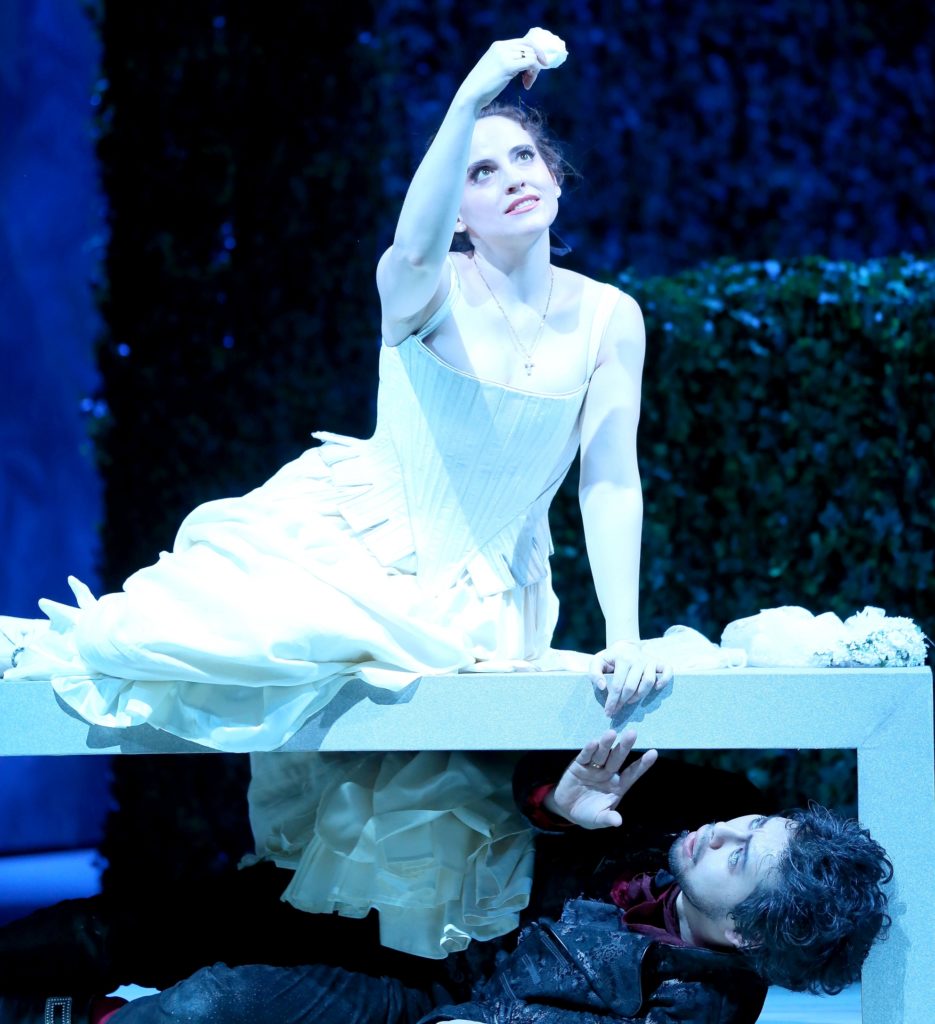 The stage set for Vienna Volksoper’s Marriage of Figaro (Die Hochzeit des Figaro) is – surprise!- a triumph of moderation and good taste. The walls of Almaviva’s palace comprise a baroque fresco – continuing on sliding screens and the circular back stage . Marc Arturo Marelli’s (2012) design is based on two baroque paintings: it’s stylish, classically simple, and endlessly fascinating. Directed by Dirk Kaftan, even over 3 hours, the lively pace never flags, choreographed like clockwork. And Volksoper Orchestra, conducted authoritatively by Anja Bihlmaier, maintained a buoyant tempo, with witty accompaniment on harpsichord (Felix Lempe).
The stage set for Vienna Volksoper’s Marriage of Figaro (Die Hochzeit des Figaro) is – surprise!- a triumph of moderation and good taste. The walls of Almaviva’s palace comprise a baroque fresco – continuing on sliding screens and the circular back stage . Marc Arturo Marelli’s (2012) design is based on two baroque paintings: it’s stylish, classically simple, and endlessly fascinating. Directed by Dirk Kaftan, even over 3 hours, the lively pace never flags, choreographed like clockwork. And Volksoper Orchestra, conducted authoritatively by Anja Bihlmaier, maintained a buoyant tempo, with witty accompaniment on harpsichord (Felix Lempe).
Figaro is actually painting the walls of the marital bedroom- even a dust-sheet hanging down- Peter Kellner’s Figaro, young, cute, with mousey-blonde hair, wearing skinny black pants, and bright-red top. But he’s a very masculine bass. Rebecca Nelsen’s Susanna sings excitedly, she’s only two steps away from her mistress. But also in reach of the Count, who’d promised to waive his (pre-nuptial) feudal rights. Bravo my lord, he sings. Cultivated, posing as ‘enlightened’, Almaviva’s just returned from London. But he’ll fight him in every corner, Figaro’s determined on an immediate wedding. Kellner’s Figaro seems very serious: not the Latin intriguer.
In the complex plotting, Almaviva is assisted by Dr.Bartolo (Andreas Mitschke) and Marcellina (Regula Rosin), his housekeeper, who Figaro once jilted. In Figaro , even the smaller parts are important, there’s a balance between all the characters.
 So Cherubino, the Count’s page, is having love-affairs all over the castle. Dismissed by the Count for seducing Barbarina, Susanna’s sister, he’s forever turning up, indestructible, like a cartoon character. Julia Koci, auburn-haired, cross-dressed in a stunning gold outfit, sings to Susanna of his troubles: every woman would destroy him . Talk to me of love, he pines, Koci’s mezzo is splendid. He jumps under the bed as the Count comes in to seduce Susanna.
So Cherubino, the Count’s page, is having love-affairs all over the castle. Dismissed by the Count for seducing Barbarina, Susanna’s sister, he’s forever turning up, indestructible, like a cartoon character. Julia Koci, auburn-haired, cross-dressed in a stunning gold outfit, sings to Susanna of his troubles: every woman would destroy him . Talk to me of love, he pines, Koci’s mezzo is splendid. He jumps under the bed as the Count comes in to seduce Susanna.
Günter Hauser’s Almaviva is youthful, slim, well-built,-wearing a moire-silk dressing gown, showing off his bare chest. Soon shirtless. No doubts about his intentions, he gets her onto the bed; Nelsen’s Susanna, has to fight him off. It’s literally a bedroom farce, with Cherubino’s head peaking under the bed which is centre-stage. Then Basilio (Jeffrey Treganza), the music teacher bursts in , and the Count himself has to hide. Until Basilo tells of Cherubino’s passion for the Countess. Furious, Almaviva breaks cover, to describe how he’d found him with Barbarina. Haumer’s is an impressive baritone- mature, with dark hints, like a fine wine. Cherubino- not again! -reappears, like a bad penny, and again banished.
The wedding cortege- peasants/servants in black- troupe in and ceremoniously cover the marital bed with a white sheet, scattering herbs and flowers. ‘The right’ exists no longer, Figaro sings, seeking reassurance. The peasants mockingly praise the Count for abandoning the ius primae noctis.
Cue Figaro’s signature aria- he’s known and respected everywhere, has fingers in everything: a man of all talents. Kellner, who looks fresh and inexperienced, lacks brio ; but not bad.
Opening Act 2, the Contessa (Kristiane Kaiser), blonde hair lavishly coiffed, lies on a bed under a pool of golden light. She sings movingly, Give me my love back, or send me death; she appeals to Amor with her song of sorrow. Kaiser’s is a lyrical, light soprano; not so powerful, but she compensates with conviction.
In the plotting and counter-plotting, Figaro passes on a letter to the Count proposing a meeting with an alleged lover, but involving Cherubino.
The scene with Susanna and the Countess is affecting, with Kaiser singing with enormous feeling. The Countess’s melancholy is counterbalanced by the farce of Cherubino dressed in Susanna’s clothes. Until Almaviva arrives, to find the door locked, suspecting the Countess of hiding Cherubino, (who escapes by jumping out of a window, while Susanna emerges triumphantly from the closet.) 
Count Almaviva is like a ‘Basil Fawlty’ (John Clees) character, his castle resembling a ramshackle hotel, with everything out of control. So in Act 3 we see Haumer’s Almaviva put on a ruby cloak with ermine, singing of the misery of his feudal role. Susanna – why does she shy away from him – agrees to meet him in the garden. Then, overhearing her telling Figaro ‘their case is won’, he feels he’s been tricked. Save the lies! he sings, in his aria, venting his fury on Figaro.- He will pay: everything serves his plan, he’ll get even with his servant. Haumer is good, but hasn’t the depths of pathos, (perhaps that come with bitter experience.) He does look suitably non-plussed presiding as Judge when Marcelina and Bartolo attempt to hold Figaro to his marriage contract – when it transpires Figaro is their lost son. Nelsen’s Susanna gives Figaro such a smack! – she’d suspected an affair with Marcelina.
The Countess’s aria (Act 3) is a plaintive cry of the deceived, much-maligned wife. Where are the moments of our love and tenderness; she only hopes his heart will listen to her plea. One of the opera’s sublime moments, poignantly sung by Kaiser.
Also impressive, the Countess’s duet with Susanna, when the Countess takes the initiative to win back her husband. They plan to change cloaks: the Count’s rendezvous to take place with Susanna dressed as the Countess. They sing of the evening breezes, of a soft summer wind blowing. Dear Countess, accept these roses; the chorus of ladies’ offer of their respects is enchanting.
The staging for the (Act 4) meeting in the garden is inspired. It’s as if we are in a maze, with blocks of closely-cropped bushes. Figaro becomes jealous -all about a pin attached to Susanna’s letter to the Count. His aria, another highlight, compellingly sung by Kellner, rages about how women really are- witches, like thorns in roses, never true. For us, a 21st century audience, it’s a tirade of misogyny. But Susanna sings to him an emollient aria of love.
In the game of amorous confusion, Figaro makes love to the Countess- dressed as Susanna, to annoy the Count. But it turns out that the ‘Susanna’ Almaviva has seduced is his own wife. And he is compelled to accept defeat, and beg on is knees for his wife’s forgiveness. Contessa, Perdono! Love excuses you, forgives, reconciles, she sings. And all is happiness in the end. (Ja, alle sind glücklich, soll’es Ende zu sein.) The chorus sing, let’s hasten to the festivities. In Marelli’s festive ending, they all unite around a table of lit candles. Da Ponte (and Beaumarchais’) happy ending is, however, problematic, a little cynical.
This Vienna Volksoper Marriage – even without the big stars- is an illuminating experience: hugely enjoyable, it gets to the heart of the opera. Marelli’s sets are exemplary: beautiful, yet simple, in some ways preferable to Martinoty’s post-modern pastiche at Vienna State Opera (Le Nozze di Figaro). But this is the German version: please, Volksoper, why are there no subtitles in English? P.R. 5.1.2018
Photos: Rebecca Nelsen (Susanna) and Yasushi Hirano (Figaro); Julia Koci (Cherubino) and Anita Götz(Susanna); Günter Hauser (Count Almaviva) and David Steffens (Figaro); Featured Image Volksoper ensemble
(c) Barbara Palffy/ Volksoper Wien
